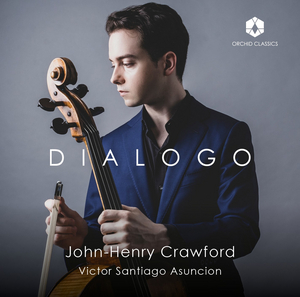Cellist John-Henry Crawford Releases 'DIALOGO'
The album will be available on Friday, June 4th.

On Friday, June 4, 2021, Orchid Classics releases DIALOGO, the debut album of cellist John-Henry Crawford, First Prize Winner of the IX International Carlos Prieto Cello Competition and the Classical Recording Foundation's 2019 Young Artist of the Year. Playing a rare 200-year-old cello smuggled out of Austria by his grandfather, Robert Popper, Crawford performs Brahms' Sonata for Piano and Cello No. 2 in F Major, Op. 99 and Shostakovich's Sonata for Cello and Piano in D minor, Op. 40 with pianist Victor Santiago Asuncion, as well as Ligeti's Sonata for Solo Cello, all recorded and engineered by GRAMMY Award-winning engineer Adam Abeshouse.
Crawford writes in the notes, "This program explores several different modes of a concept that is vital to the fabric of our lives, our relationships, and even the progress of our society as a whole - dialogue. The opening movement of the Ligeti Sonata, titled Dialogo, is an ideal musical encapsulation of this theme and the inspiration behind the title of the album. A story of unrequited love, young Ligeti fell for a fellow student, Annuss Virány, who was a cellist. He wrote the first movement as a metaphorical love duet for her. As one voice begins in inquiry, another responds, until eventually they merge together, singing in tandem. Throughout the whole sonata, these characters question, reply, plead, and even shout at one another.
"This concept is equally present in the sonatas with piano by Brahms and Shostakovich. After the grandiose introduction in Brahms' Op. 99 sonata, the two instruments pass off contrapuntal lines in a flowing 'conversation.' This musical discussion morphs into more disjunct motives, and through the use of a variety of textures and rhythmic impulses throughout the later movements, Brahms sustains this conversation as a glue that holds the entire work together.
"Finally, in the Shostakovich, we are exposed to a different mode of dialogue that, similar to Ligeti's Sonata, was born out of life events. Having fallen in love with a young translator, Shostakovich and his wife divorced for a time after she became aware of the affair. This D minor sonata was written during that period of separation and reflects Shostakovich's frame of mind - one of frustration, searching, and isolation, with the cello line as protagonist, i.e., Shostakovich. The desolate Largo suggests an inverse of this concept of dialogue. It begins in a sonic representation of a soliloquy: Shostakovich wandering and wondering to himself as he recalls motifs from the first movement. Dialogue is something we cannot live without, and it is my hope that this album can be a musical reminder to pursue more dialogue with one another, especially after a year as isolating as 2020."
Comments
Videos

